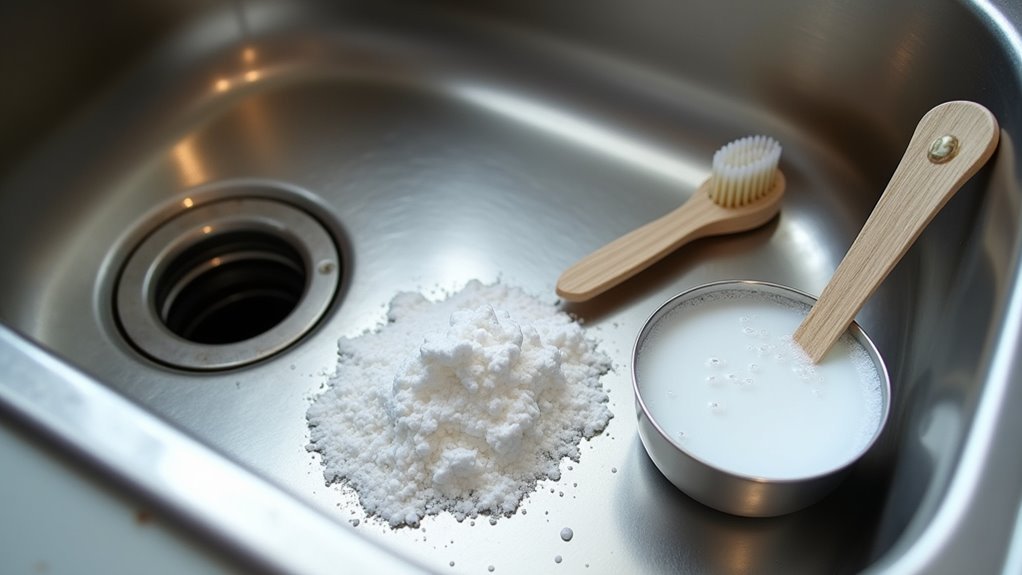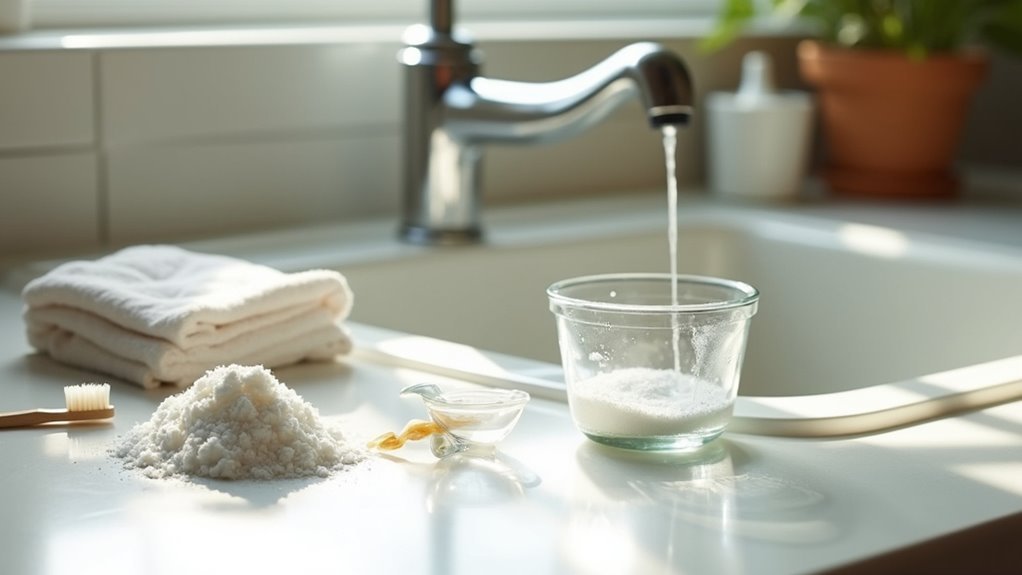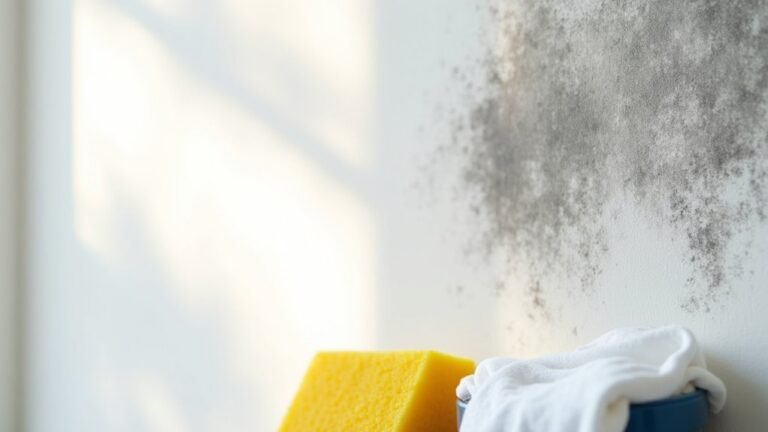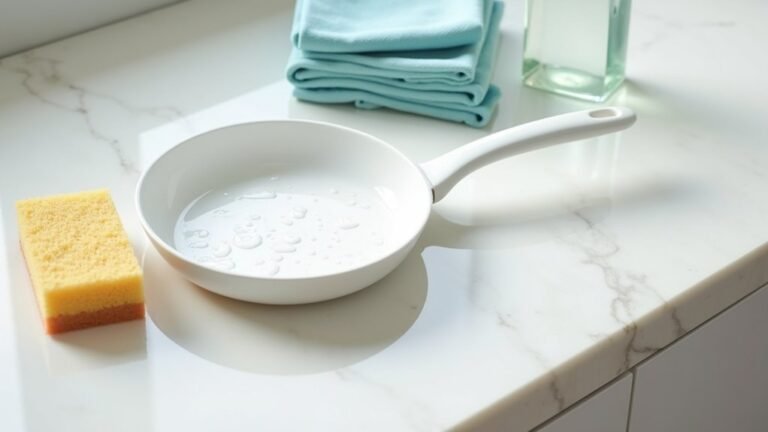We’ve all faced it – that annoying sink or shower drain that’s moving slower than a snail. Before you buy expensive drain cleaners, there’s a simple fix waiting in your kitchen cabinet. Baking soda and vinegar might remind you of those fun science class projects, but they work great at fixing small clogs and getting rid of bad smells.
According to Benjamin Franklin Plumbing, “A mixture of baking soda and vinegar creates a bubbling reaction that helps break down the gunk, hair, and grime that causes most clogs.”
The combination works like a natural drain cleaner – the baking soda and vinegar bubble up and push through the stuff that’s making your drain slow. It’s cheaper than store-bought cleaners and won’t harm your pipes. Plus, you probably already have these items at home.
Let’s look at how these everyday kitchen items can fix your drain and save you from calling a plumber.
Smelly Drain Solutions

Dealing with a stinky drain can turn even the simplest kitchen chore into an unpleasant experience. Fortunately, baking soda is a natural deodorizer that works wonders. It actually absorbs odors while breaking down the acidic residues that cause those unpleasant smells. We’ve found that combining 1 cup of baking soda with 1 cup of vinegar creates a fizzing reaction that’s pretty effective at dislodging smelly debris. Regular maintenance of sink drains is straightforward and can help prevent serious clogs and the accompanying odors that arise from neglected plumbing.
##
We’ve gathered some essential information about cleaning your drains with baking soda that’ll help you avoid common mistakes and get the best results. I think most people don’t realize that timing matters when using this natural cleaning method – you’ll want to follow specific steps for maximum effectiveness. Whether you’re dealing with a slow drain or just doing preventative maintenance, knowing what to do (and what not to do) will save you time and possibly an expensive plumber visit. Regular maintenance, including using baking soda and vinegar treatments, can prevent serious clogs and plumbing repairs.
Things to Do When Cleaning A drain with baking soda
Cleaning a drain with baking soda and vinegar is an effective, eco-friendly method to clear minor clogs without resorting to harsh chemicals.
This natural approach uses a chemical reaction between these common household ingredients to break down organic matter blocking your pipes.
The fizzing action works to dislodge debris while helping dissolve grease and soap scum that typically cause slow drains in bathrooms and kitchens.
- Remove standing water from the sink using a bucket or cup to make sure the baking soda makes direct contact with the clog.
- Pour about half a cup of baking soda directly into the drain opening to target buildup.
- Add half a cup of vinegar slowly to create the necessary fizzing reaction that helps break down the clog materials.
- Cover the drain with a plug or cloth to contain the reaction and direct it downward toward the blockage.
- Let the mixture work for 30 minutes to an hour, allowing the chemical reaction to fully penetrate the clog.
- Flush thoroughly with boiling water to wash away dissolved debris and complete the cleaning process.
- Repeat the entire process if necessary for stubborn clogs that don’t clear completely the first time.
Things to Avoid When Cleaning A drain with baking soda
Cleaning a drain with baking soda can be an effective and environmentally friendly method to remove minor clogs and eliminate odors, but there are several important precautions to keep in mind.
When used incorrectly, this natural cleaning approach can be ineffective or potentially create additional problems for your plumbing system.
- Standing water in drains: Avoid applying baking soda when water is already pooled in the sink or tub, as it will simply dissolve in the water rather than reaching the clog to break it down.
- Combining with certain chemicals: Never mix baking soda with bleach or ammonia-based cleaners, as these combinations can produce toxic chlorine gas that’s dangerous to inhale.
- Using excessive amounts: Limit baking soda to about 1/2 to 1 cup per application, as larger quantities may create residue buildup that could contribute to future clogs.
- Relying on it for severe clogs: Baking soda works best for minor blockages and odor elimination but isn’t powerful enough for major clogs caused by hair, grease, or solid materials.
- Pouring boiling water uncovered: Always cover the drain after adding baking soda and vinegar before introducing hot water to prevent messy splattering from the chemical reaction.
Steps
Clearing a clogged drain doesn’t always require harsh chemicals that can damage your pipes and harm the environment.
Using common household ingredients like baking soda and vinegar creates a natural, effective cleaning solution that can dissolve many common clogs while also neutralizing unpleasant odors.
This simple DIY method works through a basic chemical reaction where the acidic vinegar reacts with alkaline baking soda to create bubbles of carbon dioxide that help to physically dislodge debris stuck in your pipes.
Step 1: Remove any standing water from the sink using a bucket, cup, or towel.
Step 2: Pour approximately 1/2 cup of baking soda directly into the drain opening.
Step 3: Slowly pour 1/2 cup of vinegar down the drain on top of the baking soda.
Step 4: Immediately cover the drain with a cloth or drain plug to contain the reaction.
Step 5: Allow the mixture to work for 30 minutes to an hour.
Step 6: Boil a pot of water while waiting.
Step 7: Pour the boiling water down the drain to flush away the loosened debris.
Step 8: Test the drain by running tap water to check if the clog has cleared.
Step 9: Repeat the process if necessary for stubborn clogs.
Final Thoughts
Now that you’ve learned the step-by-step process, using baking soda and vinegar to clean your drains isn’t just effective—it’s actually pretty satisfying to watch that fizzy reaction do its work.
We recommend making this a weekly maintenance routine to keep your septic system healthy and prevent stubborn clogs.
For those really tough blockages, though, you might need something stronger like Liquid-Plumr.
##

Cleaning your drains with baking soda and vinegar offers a safe, effective, and economical solution to maintain your plumbing system. This natural approach not only tackles existing clogs but helps prevent future blockages when used regularly. By incorporating this simple maintenance routine into your weekly cleaning schedule, you can avoid expensive plumber visits and extend the life of your pipes. Remember that prevention is always better than dealing with a completely blocked drain. A weekly sprinkling of baking soda followed by hot water can work wonders for keeping your drains flowing freely. For stubborn clogs that resist the baking soda and vinegar treatment, you can always step up to commercial products like Liquid-Plumr, though these should be used sparingly. Additionally, using baking soda paste for cleaning can enhance the effectiveness of your maintenance routine. Take control of your home maintenance today by trying this gentle yet powerful cleaning method. Your pipes, your wallet, and the environment will all thank you for choosing a natural solution that gets the job done without harsh chemicals.






